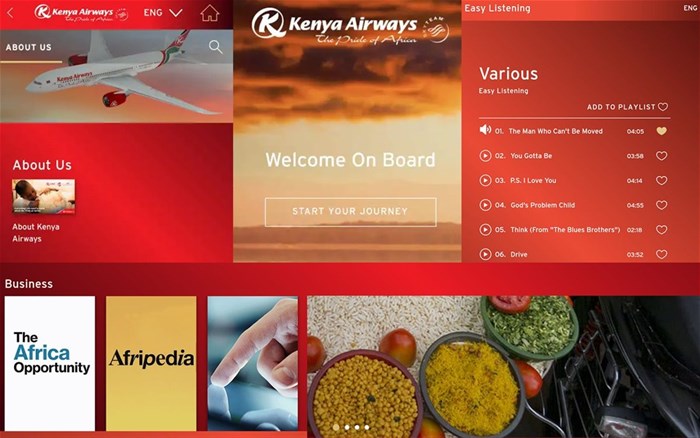The Economist magazine recently published it's 2018 edition copy marking the beginning of the year and three decades of success. It is important for us to refer to the cover of this widely read magazine because all manner of symbols full of symbolism was used and of course their interpretation varies depending on an individual context.
However, in writing this article and to remain relevant in our analysis we shall narrow down to one symbol and that is the Wi-Fi symbol. This combined with the title of the magazine, The World in 2018, clearly points out to the significant recognition of the importance of wireless connection in driving future human interaction, more so in aviation and specifically in-flight entertainment and connectivity (IFEC).
In its 2017 Global Passenger Survey, IATA clearly states that "in the effort to provide a seamless and personalised passenger journey to air travellers, the travel industry must continuously adapt to market changes and new technologies." In the same report, 73% of passengers want to browse the internet while in the air and 62% want to send/receive email and instant messaging.
This is closely intertwined with the ongoing IFEC revolution as key airlines work round the clock to meet their customers’ expectations to provide the same experience 35,000 feet up, just like while on the ground.
In penning this article, we wish to state that in-flight connectivity covers a wide range of key areas in a connected aircraft however due to our target audience for this copy, our focus is on in-flight entertainment product marketing and application. Moreover, we wish to give a standpoint into how African airlines can embrace this innovation and how vital it is to their bottom line, to their tech-savvy connected passengers and how content producers can ensure that passengers remain distracted onboard, glued to their content.
Seatback screens - will they remain or become extinct?
For close to two years now, the debate has been on the future of seatback screens whether they shall remain relevant or be extinct. In February 2017, Bloomberg.com aptly captured this in one of its publications, Your In-Flight Movie is Going Extinct - American drops seat-back viewing from its new 737 fleet as domestic flights go Wi-Fi.
Then, in September 2017, CNN Tech in its online publication money.cnn.com reported, Why those in-flight screens aren't going away. And finally, this year the Telegraph on its online platform the telegraph.co.uk reported, The death of the seat-back screen: is this the end of in-flight entertainment as we know it?
By closely looking at these publications' line of thought, the basic message being passed across is that we should prepare for a specific eventuality and that is the end of the seatback screen as we all know it. Soon, especially on shorter flights, in-flight entertainment will be best delivered wirelessly and even if seatback screens remain then it will be in the form of a tablet affixed to the seat back rather than a complex wired, custom designed screen.
Convergence
For starters, it would be prudent to know that IFEC hardware is normally produced and fitted in an aircraft for a long lifespan, sometimes up to a period of 10 years. The downside of this is that it is expensive to maintain, heavy, more prone to not operating and difficult to make desired modifications or even load new content immediately when the need arises.
However, with Wi-Fi and onboard connectivity and streaming, a new term is introduced and that is convergence. With convergence, the connected passengers can "marry" their personal devices and in-flight entertainment technology hardware onboard.
This is a very interesting development, especially for the African airlines because by adopting these technologies they can be able to reduce on fuel burn – due to unavailability of less bulky IFE systems, which are cheap to manage and the possibility of improving the technology to fit into their operational requirements.
And, of course, the connected passenger stands to benefit by having an increased passenger experience onboard as they will have the leisure to access a variety of fresh content via popular platforms like Netflix, Hulu, HBO or Amazon Video. This will be a major game changer because, as we know it, media products are highly perishable but with access to the internet, social media sites and connectivity onboard, the connected passenger will get to benefit more by having a variety of well-packaged content at their convenience to make their onboard experience memorable.
The IFEC revolution and African content
With this IFEC revolution, independent content producers also stand a chance to showcase their best productions to the global audience. A look through onboard content in most major carriers points out a grim picture of how less airtime or importance is provided to African content. Possible reasons for this vary, however. It could be that most content producers have no knowledge of the existence of this platform called IFE which they can use to showcase their productions.

Image Supplied
Also, in-flight movies are highly censored to be tolerant to passengers viewing the media onboard who come from diverse backgrounds.
But this should be such an important platform for the African producers to make use of especially considering that “film and video production are shining examples of how cultural industries, as vehicles of identity, values and meanings, can open the door to dialogue and understanding between peoples, but also to economic growth and development,” as observed by Koïchiro Matsuura, former director general of UNESCO.
Moreover, Norimitsu Onishifeb in an article published in The New York Times notes that, "Nollywood generates about 2,500 movies a year, making it the second-biggest producer after Bollywood in India, and its films have displaced American, Indian and Chinese ones on the televisions that are ubiquitous in bars, hair salons, airport lounges and homes across Africa." This is a clear pointer on the need to see more African media on onboard screens or passenger electronic devices.
The music industry in Africa is also booming, especially in East Africa, West Africa and Southern Africa. Imagine while onboard watching well mixed and packaged videos of Tanzania trademark bongo music by Ali Kiba or Diamond and then Kenya’s Sauti Soul while you are 35,000 feet in the sky cruising past Mount Kilimanjaro and the magnificent Ngorongoro crater. Indeed, this will make the whole onboard experience seamless.
How can African airlines realise this?
First, they urgently need to engage professionals in the industry who can truly provide them with key skills and competence when it comes to the selection of IFEC hardware providers who comply with airline connectivity requirements and who can deliver a reliable connectivity network at less cost.
Key people in IFEC departments of these airlines need training and refresher courses so that they can keep abreast with the ever evolving and innovative IFEC industry. This will equip them with the knowledge about what to expect next and how to fully maximise new technologies for the betterment of the airline's bottom line and the connected passenger.
To increase customer engagement, the airline can conveniently collect valuable data right from the time a passenger decides to book online, while at the airport especially, with the "smart airport" which is Wi-Fi enabled. This is a powerful platform through which the airline can present the passenger with an onboard tour even before they board. This is already happening, as this article is being written, with Airbus releasing a new iflyA380 iOS app which allows you take a 360° tour of the cabin before boarding.
Finally, by adopting and embracing IFEC platforms, African airlines can fully make use of e-commerce where they can showcase duty-free products such as designer colognes, jewellery, watches and sell basic refreshments to their customers either while onboard or before boarding. This is a definite avenue for generating ancillary revenue to the airline. Moreover, advertising opportunities become a reality whereby the airline can partner with major brands through sponsorships.
Therefore, as the exciting IFEC revolution takes shape, African airlines must comply by providing their tech-savvy passengers unrivalled customer experience onboard and African content producers a golden opportunity to tell the African story 35,000 feet in the air.























